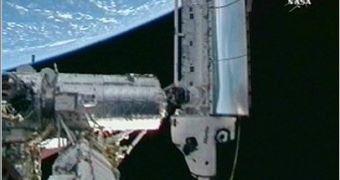Today, the space shuttle Atlantis has undocked from the International Space Station and began the journey home, after delivering to the ISS new solar power wings and a fresh crew member.
NASA is happy with the fact that the repairs to the space station went well and that the crisis of the main control computers is finally over, so the shuttle has been given the green flag to return to Earth. Officials also announced dates for two of next year's flights, although more shuttle missions are expected in 2008, including one to repair the Hubble Space Telescope.
The space agency's managers had hoped to squeeze five shuttle flights into 2007 at the beginning of the year, but a postponement in launching Atlantis made that impossible and created a domino-effect in launch delays for the rest of the year.
Commander Frederick Sturckow and pilot Lee Archambault gently eased Atlantis from its berthing port then circled the shuttle around the station while the crew took pictures of their work on the complex. The computer incident on the ISS could have delayed the Atlantis space shuttle, scheduled to return to Earth with Indian-American astronaut Sunita Williams and six others.
The best guess as to what caused the computer crash appeared to be some subtle shift in the electrically charged plasma that the station flew through as it orbited 220 miles above Earth, as the station's shape and mass expanded with the addition of the 17-ton truss segments that hold the solar wings.
"We essentially bypassed the problem," said Phil Engelauf, a Nasa mission manager, about the computer problem that Atlantis left behind when it detached from the ISS. "I wouldn't say we fixed it."
Atlantis was named after a two-masted ketch operated for the Woods Hole Oceanographic Institute from 1930 to 1966. That sailboat traveled more than half a million miles in ocean research.

 14 DAY TRIAL //
14 DAY TRIAL //